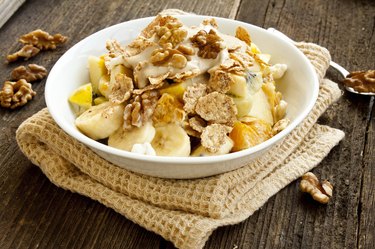
Type 2 diabetes accounts for 90 to 95 percent of all known cases of diabetes, according to the International Diabetes Federation. Type 2 diabetes occurs most often in people who have overweight over the age of 40. However, it is becoming more prevalent among younger populations with the rise in obesity. Treatment involves diet, exercise and oral medication. Carbohydrates in food have a great impact on blood sugar; knowing what foods contain carbohydrates can help you manage your diabetes.
Starches
Video of the Day
Starches contain carbohydrates, fiber and B vitamins. A serving of starch contains 80 calories and 15 g of carbohydrate. Examples of starch foods and serving sizes you can eat include 1 slice of bread, 1 oz. of a bagel, 1/2 of an English muffin, a hamburger or hot dog roll, 3/4 cup of cold cereal, 1/2 cup of hot cereal, 5 crackers, 1/2 cup of peas or corn, 1/3 cup of pasta, rice or couscous, 3 oz. baked potato and 3 cups of air-popped popcorn. For better blood sugar control, choose more whole-grain starches. Fiber in whole-grains decreases the rate of digestion allowing for a slower release of sugar into the bloodstream.
Video of the Day
Fruits
Fruits provide carbohydrate, fiber, vitamin C, potassium and folate. A typical serving of contains 60 calories and 15 g of carbohydrate. Fruit choices and serving sizes for people with type 2 diabetes include a small apple or orange, 1 cup of cantaloupe, 2 small plums, 1/2 cup of applesauce, 1 kiwi, 1 medium peach, 1/2 a large pear, 17 grapes, 4 oz. banana, 1/2 cup of unsweetened canned fruit, 2 tbsp. of raisins, 3 prunes, 1/2 cup apple or orange juice and 1/3 cup prune or cranberry juice. Whole fruit makes a better choice than the juice because of its fiber content. In addition to helping control blood sugar, fiber in fruit also helps manage hunger better than the juice.
Milk and Yogurt
In addition to being a good source of calcium and protein, milk and yogurt also contains carbohydrates. Calories in milk and yogurt vary based on the amount of fat, but the amount of carbohydrate stays the same. Low-fat and nonfat milk and yogurt foods make healthier choices than full-fat products and provide 100 calories and 12 g of carbohydrate per serving. Servings include 1 cup of milk, 1/2 cup of evaporated milk and 2/3 cup of yogurt.
Sweets and Desserts
Monitoring carbohydrate intake allows for greater flexibility in meal planning. Sweets and desserts also contain carbohydrates. If you have type 2 diabetes, you can eat these foods in moderate amounts, but a serving should replace a serving of milk, starch or fruit. For better blood sugar control, eat a sweet or dessert with a meal. Calories and carbohydrate content vary. Examples include 2 oz. of angel food cake with 30 g of carbohydrate, a 1 oz. portion of an unfrosted brownie with 15 g of carbohydrate, 3 gingersnap cookies with 15 g of carbohydrate, 1/2 cup of pudding with 30 g of carbohydrate and a 1 oz. muffin with 15 g of carbohydrate.
Is this an emergency? If you are experiencing serious medical symptoms, please see the National Library of Medicine’s list of signs you need emergency medical attention or call 911.